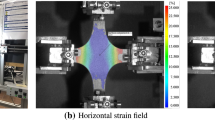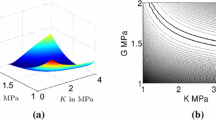Abstract
Inverse problem theory is getting of an increasing importance in mechanical modelling as it brings a solution to the identification to rheological behaviour of materials in the nonlinear range. As a matter of fact, when using inverse identification, the problem of experimental tests interpretation associated to inhomogeneous deformation states is bypassed. This allows a more accurate material parameters determination compared to the direct identification. In this paper, an inverse identification method is proposed to determine material parameters in the nonlinear range. The algorithm developed consists of a finite element based inversion scheme associated to an optimization procedure. A sensitivity analysis is used in order to determine the gradient of the cost function, representing the difference between the measured and the calculated response, with respect to the material parameters to identify. This method is applied to the inverse identification of viscoplastic parameters entering in the constitutive function that describes the flow stress of an aluminium alloy, for large range of strain, strain rate and temperature.
Similar content being viewed by others
References
BardY. 1974: Nonlinear Parameter Estimation. Academic Press, New York
Bathe, K. J. 1982: Finite Element Procedures in Engineering Analysis. In: Prentice Hall Int. (ed.). New York
BuiH. D. 1993: Introduction aux problèmes inverses en mécanique des matériaux. Eyrolles. Paris
CarrollC. W. 1961. The created response surface technique for optimizing nonlinear restrained systems. Operations Res. 9: 169–184
GelinJ. C.; GhouatiO. 1994a: An inverse method for determining viscoplastic properties of aluminium alloys. J. Mat. Processing Technology, 45: 435–440
GelinJ. C.; GhouatiO.; ShahaniR. 1994b: Apports de la simulation numérique pour l'identification du comportement rhéologique des alliages d'aluminium par essai de bipoinçonnement. J. Phys. III, France, 4: 685–706
GelinJ. C.; GhouatiO.; ShahaniR. 1994c: Modelling the plane strain compression test to obtain constitutive equations of aluminium alloys. Int. J. Mech. Sci. 36: 773–796
LevenbergK. 1944: A method for the solution of certain nonlinear problems in least squares. Quart. Appl. Math. 2: 164–168
MahnkenR.; SteinE. 1994. The identification of parameters for visco-plastic models via finite-element methods and gradient methods. Modelling Simul. Mater. Sci. Eng. 2: 597–616
MarquardtD. W. 1963: An algorithm for least squares estimation of non-linear parameters. J. Soc. Indust. Appl. Math. 11: 431–440
SchnurD. S.; ZabarasN. 1992: An inverse method for determining elastic material properties and material interface. Int. J. for Num. Meth. in Eng. 33: 2039–2057
Tarantola, A. 1987: Inverse Problem Theory. Elsevier
VidalC. A.; LeeH. S.; HaberR. B. 1991: The consistent tangent operator for design sensitivity analysis of history-dependent response. Comp. Syst. in Eng. 2: 509–523
Zienkiewicz, O. C.; Taylor, R. L. 1989: The Finite Element Method. Fourth Edition, Vol. 1, Basic Formulation and Linear Problems, McGraw Hill Book Company
Author information
Authors and Affiliations
Additional information
Communicated by S. N. Atluri, 7 February 1995
Rights and permissions
About this article
Cite this article
Gelin, J.C., Ghouati, O. An inverse method for material parameters estimation in the inelastic range. Computational Mechanics 16, 143–150 (1995). https://doi.org/10.1007/BF00369777
Issue Date:
DOI: https://doi.org/10.1007/BF00369777




